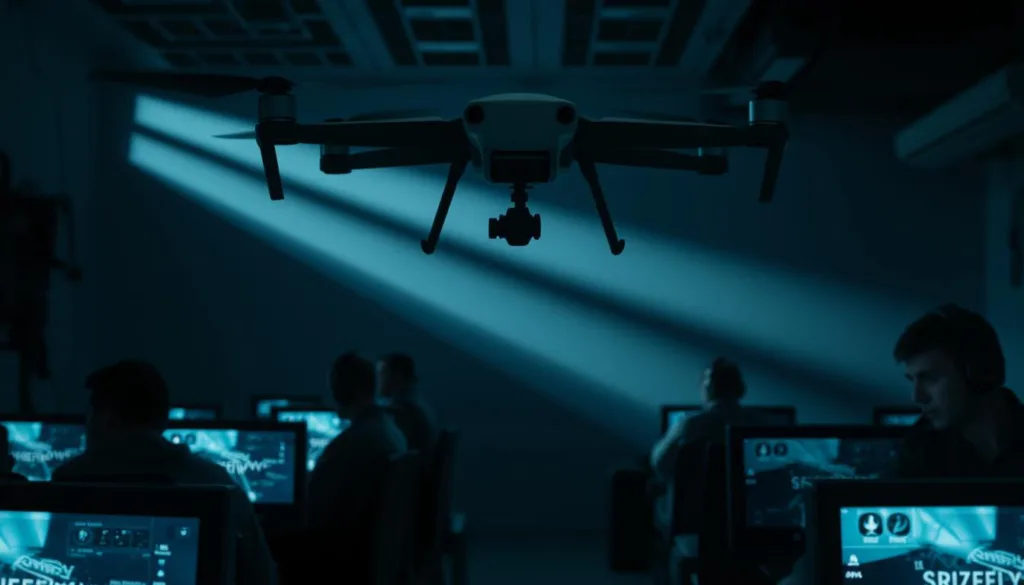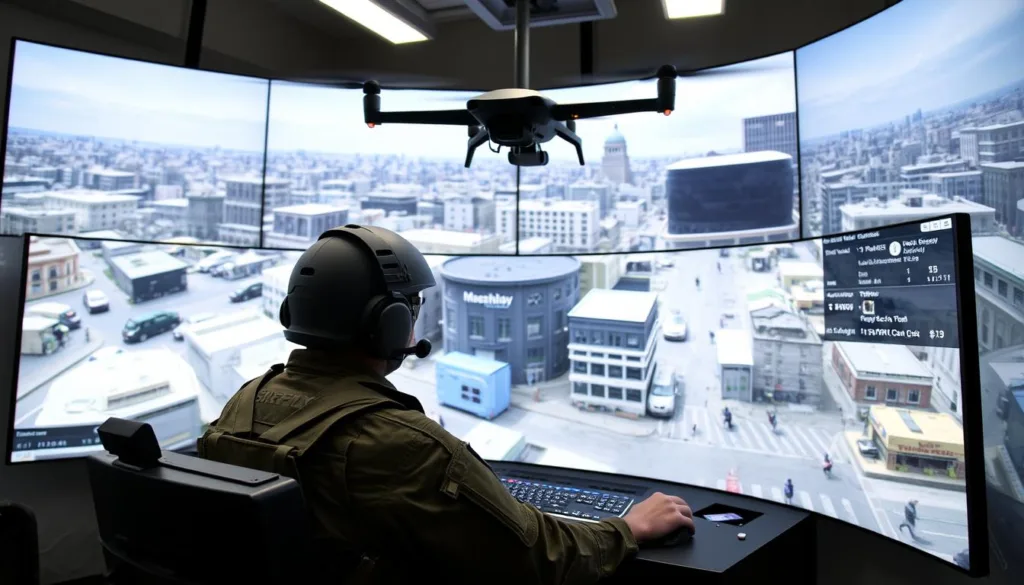The use of drone simulators has become increasingly important in modern warfare and training operations. These simulators provide a realistic environment for training drone operators, allowing them to gain practical experience without the risks associated with real-world flights.
By bridging the gap between theoretical knowledge and practical application, drone simulators play a crucial role in preparing operators for combat situations. The benefits of using simulators include reduced costs, improved safety, and enhanced training effectiveness.
Key Takeaways
- Drone simulators are crucial for modern warfare and training operations.
- They provide realistic training environments for drone operators.
- Simulators help bridge the gap between theoretical and practical knowledge.
- The use of simulators reduces costs and improves safety.
- Enhanced training effectiveness is a significant benefit of drone simulators.
The Evolution of Military Drone Simulators
The evolution of drone warfare has necessitated the development of sophisticated simulators for military training. As modern warfare continues to evolve, the role of drones in combat has become increasingly significant.
From Basic Training Tools to Advanced Combat Simulators
Initially, drone simulators were basic training tools, but they have evolved into advanced combat simulators. These simulators now offer realistic scenarios that prepare drone operators for the complexities of warfare. The advancement in simulator technology has directly impacted the effectiveness of training programs.
The Growing Importance in Modern Warfare
The importance of drone simulators in modern warfare cannot be overstated. Current military doctrine has evolved to incorporate drone operations, highlighting the need for sophisticated training tools. Effective drone simulation training has been shown to enhance mission success rates and improve the strategic and tactical advantages provided by well-trained drone operators.
Why Military Drone Simulators Are Essential for Training
As modern warfare evolves, the importance of military drone simulators in training cannot be overstated. These simulators provide a realistic and immersive environment for personnel to develop their skills.

Cost-Effective Training Solution
Military drone simulators offer a cost-effective solution for training by reducing the need for physical drones and minimizing the risk of damage or loss. This approach enables personnel to train extensively without incurring significant costs.
Risk-Free Environment for Skill Development
A drone simulator provides a risk-free environment where trainees can practice and hone their skills without the fear of causing damage or injury. This safe environment fosters confidence and competence in operating drones.
Realistic Combat Scenario Preparation
Modern drone simulators are capable of recreating authentic combat conditions, allowing personnel to prepare for real-world scenarios. By simulating various warfare scenarios, trainees can develop the skills needed to respond effectively in high-pressure situations.
Top Military Drone Simulators on the Market
With the increasing demand for drone technology, simulators have become a crucial tool for military training. The market is filled with various options, each offering unique features and capabilities.
FPV Military Kamikaze Drone Simulator

Overview
The FPV Military Kamikaze Drone Simulator is designed for realistic training, offering an immersive experience with its first-person view (FPV) technology. It simulates various combat scenarios, preparing pilots for real-world missions.
Pros
Realistic Combat Scenarios: The simulator offers a range of combat scenarios, enhancing pilot readiness. Customizable Settings: Users can adjust settings to suit their training needs.
Cons
Limited Advanced Features: Some users may find the feature set limited compared to more advanced simulators. Hardware Requirements: Specific hardware is required for optimal performance.
Features
FPV Technology: Provides an immersive training experience. Customizable Mission Scenarios: Allows for tailored training exercises.
FPV Drone Kamikaze

Overview
The FPV Drone Kamikaze simulator focuses on high-intensity training, simulating kamikaze drone operations. It’s designed for pilots to practice high-risk missions in a controlled environment.
Pros
High-Intensity Training: Prepares pilots for extreme scenarios. Realistic Drone Behavior: Simulates realistic drone behavior, enhancing training effectiveness.
Cons
Steep Learning Curve: May require significant time to master. Limited Multiplayer Options: Primarily designed for single-player training.
Features
Realistic Drone Simulation: Offers accurate drone behavior and response. Customizable Difficulty Levels: Allows users to adjust the training intensity.
Professional Military-Grade Simulators

Overview
Professional Military-Grade Simulators are designed for advanced training, offering sophisticated features such as networked training environments and customizable mission scenarios. These simulators are used by military forces worldwide for comprehensive training.
Pros
Advanced Features: Includes networked training and customizable scenarios. Realistic Training: Offers highly realistic training environments.
Cons
High Cost: These advanced simulators are typically expensive. Complex Setup: Requires specialized knowledge for setup and operation.
Features
Networked Training Environments: Enables team-based training exercises. Performance Tracking: Allows for continuous improvement through detailed performance analysis.
Key Features of Effective Military Drone Simulators
To ensure optimal performance, military drone simulators must incorporate several key features. Effective simulators provide a realistic and immersive training environment that prepares drone operators for the challenges of real-world missions.
Realistic Flight Physics and Controls
A critical aspect of any military drone simulator is its ability to accurately replicate the flight characteristics of actual drones. This includes realistic flight physics and controls that mimic the behavior of the drone in various conditions, allowing operators to develop the necessary skills for effective drone operation.
Advanced Mission Scenarios
Advanced mission scenarios are another essential feature of effective military drone simulators. These scenarios should simulate a wide range of potential combat situations, enabling trainees to practice and hone their skills in a controlled environment. This prepares them for the complexities of real-world training scenarios.
Performance Tracking and Feedback Systems
Feedback mechanisms are vital in military drone simulators, as they provide trainees with insights into their performance. Metrics such as Target Acquisition Time, Weapons Accuracy, and Mission Completion Rate are crucial for evaluating a trainee’s proficiency. The simulator should offer detailed analysis and feedback to enhance skill development.
Effective simulators capture and analyze performance metrics to provide a comprehensive understanding of a trainee’s capabilities. This includes detailed analysis of how performance metrics are captured and analyzed, discussion of the types of feedback mechanisms that accelerate skill development, and examination of how data visualization tools help instructors identify training needs.
Training Standards and Performance Metrics
Effective training standards and performance metrics are crucial for the successful operation of military drone simulators. These standards ensure that drone operators are adequately prepared for real-world missions.
UAV Pilot Certification Requirements
To become certified, UAV pilots must undergo rigorous training programs that cover both theoretical knowledge and practical skills. These programs are designed to meet specific certification requirements.
Critical Performance Metrics
Critical performance metrics for UAV pilots include accuracy, response time, and decision-making under pressure. These metrics are used to evaluate pilot performance during simulated missions.
Continuous Proficiency Evaluation
Continuous proficiency evaluation involves regular assessments to ensure that drone operators maintain their skills. This process includes feedback mechanisms and development Regular evaluations help identify areas for improvement, enabling targeted training and enhancing overall unit readiness.
Regular evaluations help identify areas for improvement, enabling targeted training and enhancing overall unit readiness.
Hardware Compatibility for Immersive Training
To maximize the benefits of military drone simulators, it’s crucial to understand the hardware requirements for seamless integration. Effective training depends on compatible hardware that can support the simulator software.
VR Headset Options

For an immersive experience, VR headsets are essential. Popular options include those compatible with PC-based systems, ensuring a smooth and realistic simulation. The choice of VR headset can significantly impact the training experience.
RC Transmitter Integration

RC transmitters play a critical role in drone simulation training. The FPV Drone Kamikaze simulator recommends using an RC transmitter for realistic control. Integration involves connecting the transmitter to the simulation software, allowing for precise control and feedback.
The system requirements for the FPV Drone Kamikaze simulator include a 64-bit Windows 8.1 or Windows 10 OS, Intel Core i3-4340 or AMD FX-6300 processor, 8 GB RAM, and NVIDIA GeForce RTX 1060 graphics. Meeting these requirements ensures a smooth training experience.
Real-World Applications and Success Stories
Military drone simulators have revolutionized training programs worldwide. By providing a realistic and immersive environment, these simulators have significantly improved the readiness and effectiveness of drone operators.
Military Training Programs
The integration of drone simulators into military training programs has shown remarkable results. For instance, the FPV Drone Kamikaze simulator has received very positive reviews, with 88% of 8,627 all-time reviews being positive. This has fostered a strong community of players who share tips and strategies, enhancing the overall training experience.
Operational Readiness Improvements
Simulator training has led to significant improvements in operational readiness. Operators trained in simulators have demonstrated better adaptability and flexibility in real-world scenarios, making them more effective in combat situations. The simulator environment allows for a game-like experience, where operators can practice and hone their skills without the risks associated with real-world training.
By analyzing the performance of simulator-trained operators, it’s clear that they outperform traditionally trained operators. The data indicates a reduction in time-to-deployment and an increase in mission success rates, ultimately contributing to a more proficient community of drone operators.
Conclusion: The Future of Military Drone Simulation
As military drone technology continues to evolve, the role of simulation in training is becoming increasingly vital. The future of drone simulation is poised to revolutionize training and operations by incorporating emerging technologies like artificial intelligence.
The drone simulator market is expected to grow, driven by the expanding role of drone warfare in military strategy. The community of players and operators will continue to provide valuable feedback, shaping the evolution of these simulators.
With new features and enhanced game-like experiences, military drone simulators will become more effective tools for combat readiness. The integration of AI will further enhance training effectiveness, making drone simulators indispensable in modern warfare.
FAQ
What are the system requirements for running a combat drone simulator?
To run a smooth drone warfare simulation, you’ll need a computer with at least an Intel Core i5 or AMD Ryzen 7 processor, 16 GB of RAM, and a dedicated graphics card. The exact requirements may vary depending on the specific simulator you’re using.
Can I use a VR headset with a drone simulator?
Yes, many modern drone simulators support VR headsets, providing an immersive training experience. Check the simulator’s specifications to ensure compatibility with your VR headset.
How realistic are the flight physics in these simulators?
Top-notch drone simulators feature realistic flight physics and controls, allowing you to develop and hone your skills in a lifelike environment. The level of realism can vary between simulators, so it’s worth checking reviews and feedback from other users.
Are there any artificial intelligence features in these simulators?
Some advanced drone simulators incorporate artificial intelligence to create more realistic mission scenarios and adaptive enemy behaviors, enhancing the overall training experience.
Can I create custom mission scenarios?
Many drone simulators allow you to create custom mission scenarios, enabling you to tailor your training to specific needs and objectives. Check the simulator’s features to see if this is an option.
What kind of feedback systems are available in these simulators?
Effective drone simulators often include performance tracking and feedback systems, helping you identify areas for improvement and monitor your progress over time.
Is there a community for users to share their experiences and tips?
Many drone simulator developers have an active community where users can share their experiences, provide feedback, and exchange tips on how to get the most out of the simulator.



